Mitotic exit and separation of mother and daughter cells
- PMID: 23212898
- PMCID: PMC3512134
- DOI: 10.1534/genetics.112.145516
Mitotic exit and separation of mother and daughter cells
Abstract
Productive cell proliferation involves efficient and accurate splitting of the dividing cell into two separate entities. This orderly process reflects coordination of diverse cytological events by regulatory systems that drive the cell from mitosis into G1. In the budding yeast Saccharomyces cerevisiae, separation of mother and daughter cells involves coordinated actomyosin ring contraction and septum synthesis, followed by septum destruction. These events occur in precise and rapid sequence once chromosomes are segregated and are linked with spindle organization and mitotic progress by intricate cell cycle control machinery. Additionally, critical paarts of the mother/daughter separation process are asymmetric, reflecting a form of fate specification that occurs in every cell division. This chapter describes central events of budding yeast cell separation, as well as the control pathways that integrate them and link them with the cell cycle.
Figures


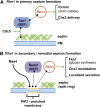

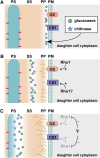


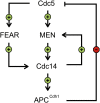


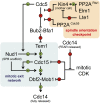
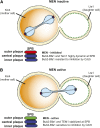





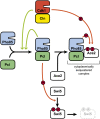


Similar articles
-
A defect of Kap104 alleviates the requirement of mitotic exit network gene functions in Saccharomyces cerevisiae.Genetics. 2002 Dec;162(4):1545-56. doi: 10.1093/genetics/162.4.1545. Genetics. 2002. PMID: 12524331 Free PMC article.
-
Dependence of Chs2 ER export on dephosphorylation by cytoplasmic Cdc14 ensures that septum formation follows mitosis.Mol Biol Cell. 2012 Jan;23(1):45-58. doi: 10.1091/mbc.E11-05-0434. Epub 2011 Nov 9. Mol Biol Cell. 2012. PMID: 22072794 Free PMC article.
-
The Saccharomyces cerevisiae Mob2p-Cbk1p kinase complex promotes polarized growth and acts with the mitotic exit network to facilitate daughter cell-specific localization of Ace2p transcription factor.J Cell Biol. 2002 Sep 2;158(5):885-900. doi: 10.1083/jcb.200203094. Epub 2002 Aug 26. J Cell Biol. 2002. PMID: 12196508 Free PMC article.
-
The final cut: cell polarity meets cytokinesis at the bud neck in S. cerevisiae.Cell Mol Life Sci. 2016 Aug;73(16):3115-36. doi: 10.1007/s00018-016-2220-3. Epub 2016 Apr 16. Cell Mol Life Sci. 2016. PMID: 27085703 Free PMC article. Review.
-
Assembling the spindle midzone in the right place at the right time.Cell Cycle. 2008 Feb 1;7(3):283-6. doi: 10.4161/cc.7.3.5349. Epub 2007 Nov 21. Cell Cycle. 2008. PMID: 18235228 Review.
Cited by
-
The budding yeast GSK-3 homologue Mck1 is an essential component of the spindle position checkpoint.Open Biol. 2022 Nov;12(11):220203. doi: 10.1098/rsob.220203. Epub 2022 Nov 2. Open Biol. 2022. PMID: 36321416 Free PMC article.
-
A capsule-associated gene of Cryptococcus neoformans, CAP64, is involved in pH homeostasis.Microbiology (Reading). 2021 Jun;167(6):001029. doi: 10.1099/mic.0.001029. Microbiology (Reading). 2021. PMID: 34125663 Free PMC article.
-
Essential role of the endocytic site-associated protein Ecm25 in stress-induced cell elongation.Cell Rep. 2021 May 18;35(7):109122. doi: 10.1016/j.celrep.2021.109122. Cell Rep. 2021. PMID: 34010635 Free PMC article.
-
Transfer of the Septin Ring to Cytokinetic Remnants in ER Stress Directs Age-Sensitive Cell-Cycle Re-entry.Dev Cell. 2019 Oct 21;51(2):173-191.e5. doi: 10.1016/j.devcel.2019.08.017. Epub 2019 Sep 26. Dev Cell. 2019. PMID: 31564614 Free PMC article.
-
Amn1 governs post-mitotic cell separation in Saccharomyces cerevisiae.PLoS Genet. 2018 Oct 1;14(10):e1007691. doi: 10.1371/journal.pgen.1007691. eCollection 2018 Oct. PLoS Genet. 2018. PMID: 30273335 Free PMC article.
References
Publication types
MeSH terms
Substances
Grants and funding
LinkOut - more resources
Full Text Sources
Molecular Biology Databases

